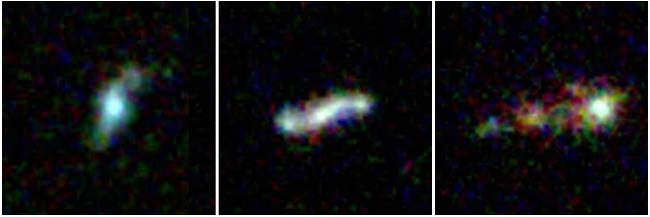Baby Versions of Milky Way Spotted

Astronomershave spotted small galaxies near the beginning of time that resemble ancestorsof our own galactic home.
The tinygalaxies are about one-tenth to one-twentieth the size of the Milky Way andhave 40 times fewer stars. Light from the ancient clusters was emitted about 2billion years after the Big Bang, the theoretical beginning to the universethat occurred about 13.7 billion years ago. So the galaxies are seen asthey existed in a very young universe.
Thegalaxies are not the most distant seen by the Hubble Space Telescope, butastronomers consider them to be the best evidence of precursors to larger,spiral structures such as the Milky Way.
?Findingthese objects and discovering that they are a step in the evolution of ourgalaxy is akin to finding a key fossil in the path of human evolution,? saidEric Gawiser, an astronomer at the Rutgers School of Arts and Sciences.
Gawiser andCaryl Gronwall, an astrophysicist at Pennsylvania State University, detailedtheir findings today at the American Astronomical Society (AAS) annual meetingin Austin, Texas.
?They comein a variety of shapes — round, oblong and even somewhat linear — and we arestarting to make precise measurements of their sizes," Gronwall said ofthe spiral galaxies, which are made mostly of hot, bright stars that emit aunique "Lyman alpha" signature of ultraviolet light.
Statisticalanalyses and computer simulations of how galaxies bump into one another ledGronwall and Gawiser to conclude that galaxies with strong Lyman alpha signaturesare the ancestorsof spiral galaxies.
Get the Space.com Newsletter
Breaking space news, the latest updates on rocket launches, skywatching events and more!
?We knew byour understanding of cosmological theory that spiral galaxies had to evolvefrom low-mass galaxies such as these,? Gawiser said. ?The challenge was toactually find them. We?d seen other early universe galaxies, but they werebigger and destined to evolve into elliptical galaxies, not spirals.?
NigelSharp, a program officer at the National Science Foundation's Division ofAstronomical Sciences who was not involved in the work, said Gronwall andGawiser used Hubbleand other observatories to extract an important finding.
"Thisteam has come the closest yet to finding young galaxies that resemble our ownMilky Way in its infancy," Sharp said.
- Video: Hubble Repair Missions
- The Best Hubble Images
- Video: Death Star Galaxy
Join our Space Forums to keep talking space on the latest missions, night sky and more! And if you have a news tip, correction or comment, let us know at: community@space.com.
Dave Mosher is currently a public relations executive at AST SpaceMobile, which aims to bring mobile broadband internet access to the half of humanity that currently lacks it. Before joining AST SpaceMobile, he was a senior correspondent at Insider and the online director at Popular Science. He has written for several news outlets in addition to Live Science and Space.com, including: Wired.com, National Geographic News, Scientific American, Simons Foundation and Discover Magazine.









